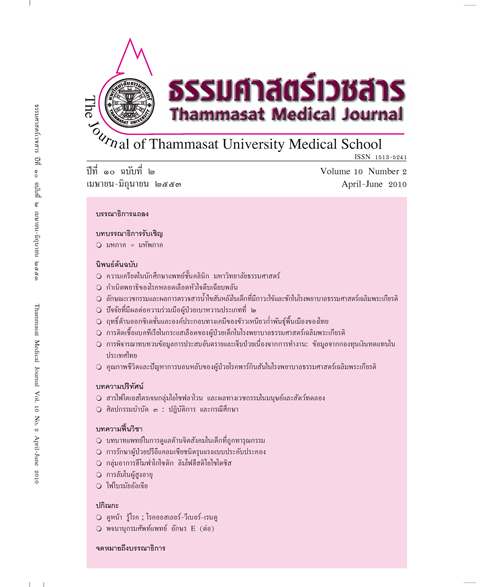Clinical characteristics and cerebrospinal fluid profiles in children presenting with fever and seizure at Thammasat University Hospital
Keywords:
Febrile seizure, Clinical manifestation, Cerebrospinal fluid analysis, ChildrenAbstract
Background: Fever with seizure is a common neurological problem in children. In clinical practice, the possibilityof central nervous system infection should be excluded before diagnosing febrile seizure.
Objective: To study the clinical manifestations and cerebrospinal fluid profiles in children presenting withfever and seizure at Thammasat University Hospital.
Methodology: A retrospective descriptive study of the children age 3 months to 5 years who presented withfever and seizure at Thammasat University Hospital during January 1st, 2004 to December 31st,2006. Lumbar puncture was performed in all cases.
Results: 74 children (3 months to 5 years old) with fever and seizure were eligible for the study. Most(63.5%) of them were between 3 months to 1 year old. Family history of febrile seizure presentedin 18.6%. Most of them had body temperature between 38.0-38.9°C and simple febrile seizuretype described as seizure in the first 24 hours of fever, seizure less than 15 minutes in duration,no repeated seizure and generalized seizure type. Approximately 61 percent of the patients hadno postictal conscious change. Poor feeding, lethargy, vomiting, irritability, meningeal irritationand anterior fontanel bulging were found in 36.8%, 32.8%, 25.7%, 14.3%, 2.7% and 1.8% respectively.Most of them (95.9%) had normal cerebrospinal fluid profiles. Three subjects (4.1%) ages4 months, 12 months and 48 months old, who had abnormal cerebrospinal fluid results, hadprolonged fever more than 24 hours, recurrent seizures within 24 hours and no signs of meningealirritation. These three patients were finally diagnosed with bacterial meningitis, viral meningitisand viral encephalitis respectively.
Conclusion: Febrile seizure was known as a benign condition without evidence of central nervous systeminfection. However, the physician should consider performing lumbar puncture according to theguideline or in highly suspicious patients.
Key words: Febrile seizure, Clinical manifestation, Cerebrospinal fluid analysis, Children



